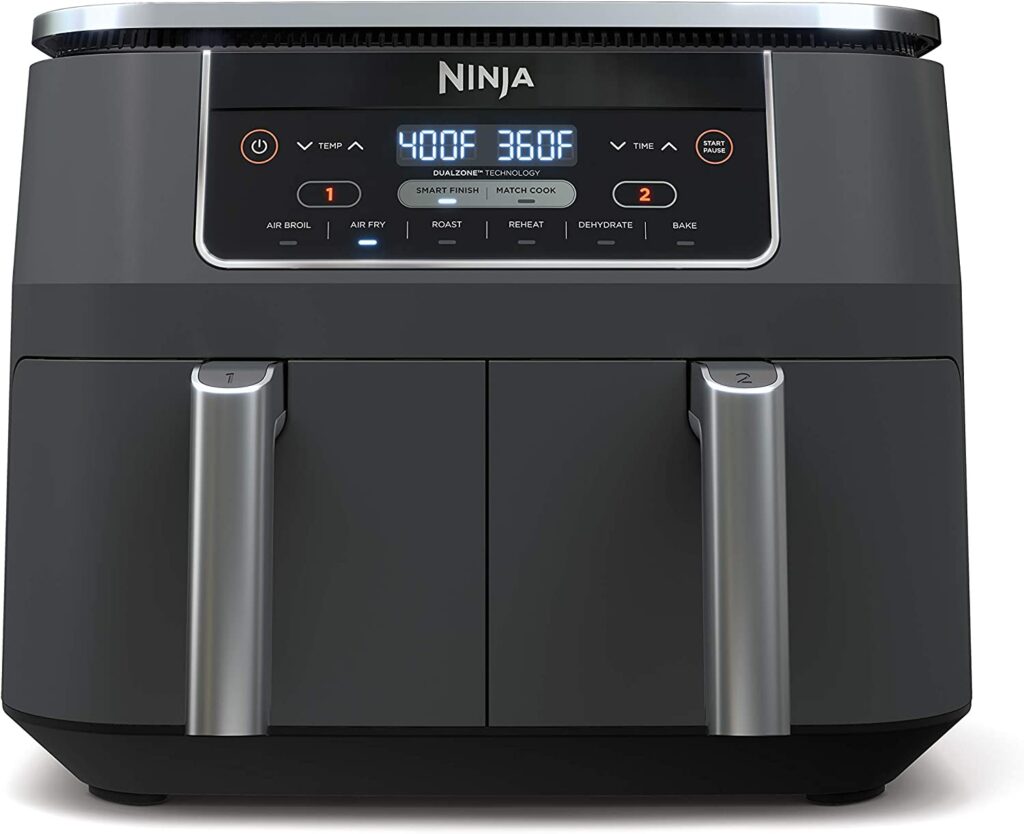The Ultimate Turkey Overnight Air Fryer Recipe Guide: A Delicious And Convenient Option For Turkey Lovers
Are you looking for a quick and easy way to cook a delicious turkey? Look no further! In this comprehensive guide, we will explore the world of turkey overnight air frying. We will delve into the food science behind this cooking method, discuss culinary details, selection, cleaning, preparation, and provide tips, variations, and doneness checks. So without further ado, let’s get started and create the perfect turkey feast!
Understanding the Science behind Overnight Air Frying
The process of overnight air frying involves cooking a turkey slowly using hot air circulation within the fryer. This cooking method ensures the entire turkey is evenly cooked, resulting in juicy and flavorful meat with a perfectly crisp skin. The combination of hot air and the overnight cooking process allows the meat to become tender and succulent, making it a favorite choice for turkey enthusiasts.
Selecting the Perfect Turkey
Before diving into the cooking process, it is crucial to choose the right turkey for your air frying adventure. Here are some important factors to consider:
Size matters
Ensure that the turkey fits comfortably inside your air fryer. Most air fryers can accommodate turkeys up to 16 pounds, but be sure to check your specific model’s capacity.
Fresh or Frozen?
Both fresh and frozen turkeys can be used for air frying. If using a frozen turkey, make sure to thaw it completely before starting the cooking process. Thawing times may vary, so refer to the packaging or USDA guidelines for accurate information.
Consider the Meat Quality
Opt for a high-quality turkey from a trusted source to enhance the flavor and overall satisfaction. Organic, free-range, or heritage turkeys are often favored for their superior taste and texture.
Cleaning and Preparing Your Air Fryer
Properly cleaning and preparing your air fryer is essential to ensure delicious and safe results. Follow these steps:
Clean the Basket and Tray
Remove the basket and tray from your air fryer and wash them with warm soapy water. Scrub off any residue or oil buildup, ensuring they are thoroughly clean.
Check for Grease Buildup
Inspect the inside of your air fryer for any accumulated grease or debris. Wipe it down with a damp cloth or sponge. Make sure to remove any stubborn residue, as it can affect the flavor of your turkey.
Give It a Final Rinse
Rinse all the parts with warm water to remove any soap residue. Dry them completely before reassembling your fryer.
Preparing Your Turkey for Overnight Air Frying
Now that your air fryer is pristine, it’s time to prepare your turkey for the overnight cooking adventure. Follow these steps:
Remove the Giblets
Check the thawed turkey’s cavity for giblets (such as the heart, liver, and gizzard) and remove them. These can be set aside for making a flavorful gravy later.
Rinse and Pat Dry
Rinse the turkey under cold water to remove any excess brine or marinade. Pat it dry with paper towels to ensure crispier skin.
Seasoning and Flavoring Options
Now that your turkey is dry, the fun part begins – seasoning! Generously apply your choice of seasonings to enhance the taste. Common options include salt, pepper, garlic powder, paprika, rosemary, thyme, or a pre-made turkey seasoning blend. You can even experiment with unique spice combinations to make it your own.
Flavor Infusion Techniques
To add even more flavors, consider injecting the turkey with a marinade or your preferred liquid combination. This technique ensures that the flavors penetrate deep into the meat, resulting in a moist and flavorful outcome.
Important Tips for a Successful Turkey Overnight Air Fryer Cooking
While the overall process of overnight air frying is straightforward, these tips can further enhance your cooking experience:
Use Cooking Oil Spray
Before placing the turkey inside the air fryer, lightly spray it with cooking oil. This will facilitate browning and improve the skin’s crispiness.
Trussing the Turkey
Trussing your turkey, or tying the legs and wings with cooking twine, helps create a compact shape for even cooking. It also prevents the extremities from overcooking or drying out.
Add Moisture
To prevent the turkey from drying out during the long cooking process, consider placing a tray of water or broth in the bottom of the air fryer. This will provide additional moisture and help retain the turkey’s juiciness.
Keep an Eye on the Skin
To achieve that desired crispy skin, monitor the turkey’s cooking progress. If the skin is browning too quickly, cover it loosely with aluminum foil during the cooking process.
Utilize a Meat Thermometer
To ensure your turkey is perfectly cooked, use a meat thermometer to check its internal temperature. The desired temperature should be 165°F (74°C) in the thickest parts of the meat without touching any bones.
Variations and Flavor Profiles
One of the most exciting elements of cooking is customization. Here are a few variation ideas and flavor profiles to experiment with:
Citrus Herb Infusion
Inject your turkey with a mixture of citrus juice (such as orange or lemon) and herbs (like rosemary and thyme). This creates a refreshing twist and adds zesty flavors to your bird.
Smoky BBQ Rub
Coat your turkey with a smoky BBQ rub, giving it a delightful tang with a hint of sweetness. This variation adds a unique spin, perfect for those who enjoy a bit of heat and complexity.
Asian Fusion
Create an Asian-inspired turkey by marinating it in soy sauce, ginger, garlic, and sesame oil. This fusion-style turkey offers aromatic, umami-rich flavors that will leave your taste buds wanting more.
Doneness Checks: Ensuring Perfection
To guarantee your turkey is cooked to perfection, perform these essential doneness checks:
Visual Examination
Check the skin’s color – it should be a rich, golden brown. This indicates that the turkey is well-cooked on the outside.
Internal Temperature
Verify the turkey’s internal temperature using a meat thermometer. Ensure it reaches 165°F (74°C) in the thickest parts, without touching the bone. This confirms that the meat is thoroughly cooked and safe to eat.
Juices Run Clear
Pierce the turkey with a meat fork or skewer. If the juices run clear without any traces of blood or pink color, your turkey is ready to be devoured!
The Ultimate Turkey Overnight Air Fryer Recipe
Now that you are armed with all the necessary knowledge about turkey overnight air frying let’s dive into the basic recipe:
Ingredients:
- 1 whole turkey (size of your choice)
- Seasonings of your preference (salt, pepper, garlic powder, etc.)
Instructions:
- Preheat your air fryer to 325°F (165°C).
- Clean, prepare, and season the turkey as outlined in the earlier sections.
- Place the turkey in the air fryer basket or tray, breast-side up.
- Cook the turkey in the air fryer for approximately 20 minutes per pound. For example, a 12-pound turkey will require about 4 hours of cooking time. Adjust accordingly based on your turkey’s weight.
- Insert a meat thermometer into the thickest part, avoiding contact with bones. Ensure it reaches 165°F (74°C).
- Once the turkey reaches the desired temperature, carefully remove it from the air fryer, placing it on a cutting board or platter.
- Allow the turkey to rest for 15-20 minutes to allow the juices to redistribute.
- Carve and serve your delicious overnight air-fried turkey with your favorite sides and sauces.
In Conclusion: A Perfect Option for Turkey Lovers
Turkey overnight air frying offers a convenient and delicious way to prepare your favorite bird. From the science behind the process to selecting the right turkey, cleaning, preparation, and various flavor profiles – this guide has covered all the essential aspects.
Remember, the key to achieving a mouthwatering turkey is in the details: proper cleaning, precise seasoning, cooking with caution, and ensuring doneness. With this comprehensive guide, you are now equipped to impress your friends and family with a succulent and perfectly cooked overnight air-fried turkey!
So, why wait? Gather your ingredients, fire up your air fryer, and get ready to enjoy a memorable turkey feast like never before!
Sources
FAQS On Turkey Overnight Air Fryer Recipe
What Is A Turkey Overnight Air Fryer Recipe?
Turkey overnight air fryer recipe is a method of cooking a whole turkey in an air fryer appliance overnight. This cooking technique ensures a juicy and flavorful turkey with a crispy skin.
How Does A Turkey Overnight Air Fryer Recipe Work?
The turkey is prepared by seasoning it with herbs and spices, and then placed in the air fryer. The air fryer uses hot air circulated around the turkey to cook it slowly and evenly overnight. The long cooking time allows for the flavors to infuse into the meat, resulting in a moist and delicious turkey.
Can I Use A Frozen Turkey For The Overnight Air Fryer Recipe?
It is highly recommended to use a thawed turkey for the overnight air fryer recipe. Cooking a frozen turkey in an air fryer may result in uneven cooking and can be a safety hazard. Ensure that your turkey is completely thawed before attempting this recipe.
How Long Does It Take To Cook A Turkey Using The Overnight Air Fryer Recipe?
The cooking time for a turkey using the overnight air fryer recipe will depend on the size of the turkey and the specific model of your air fryer. As a general guideline, allow around 7-9 hours for a 12-14 pound turkey. It is important to check the internal temperature of the turkey with a meat thermometer to ensure it has reached the recommended safe temperature of 165°F (74°C).
Do I Need To Flip Or Rotate The Turkey During The Overnight Air Frying Process?
No, flipping or rotating the turkey is not necessary during the overnight air frying process. The air fryer’s circulation of hot air ensures even cooking on all sides of the turkey. In fact, opening the air fryer unnecessarily can slow down the cooking process and affect the overall result.
Can I Stuff The Turkey When Using The Overnight Air Fryer Recipe?
It is not recommended to stuff the turkey when using the overnight air fryer recipe. Stuffing the turkey can affect the cooking time and may not reach the safe internal temperature of 165°F (74°C). It is safer to cook the stuffing separately.
Can I Use The Drippings From The Turkey For Gravy?
Yes, you can use the drippings collected at the bottom of the air fryer to make gravy. Once the turkey is cooked, carefully remove it from the air fryer and pour the drippings into a separate container. Allow the drippings to settle, then separate the fat from the juices. Use the juices to make a flavorful gravy.


